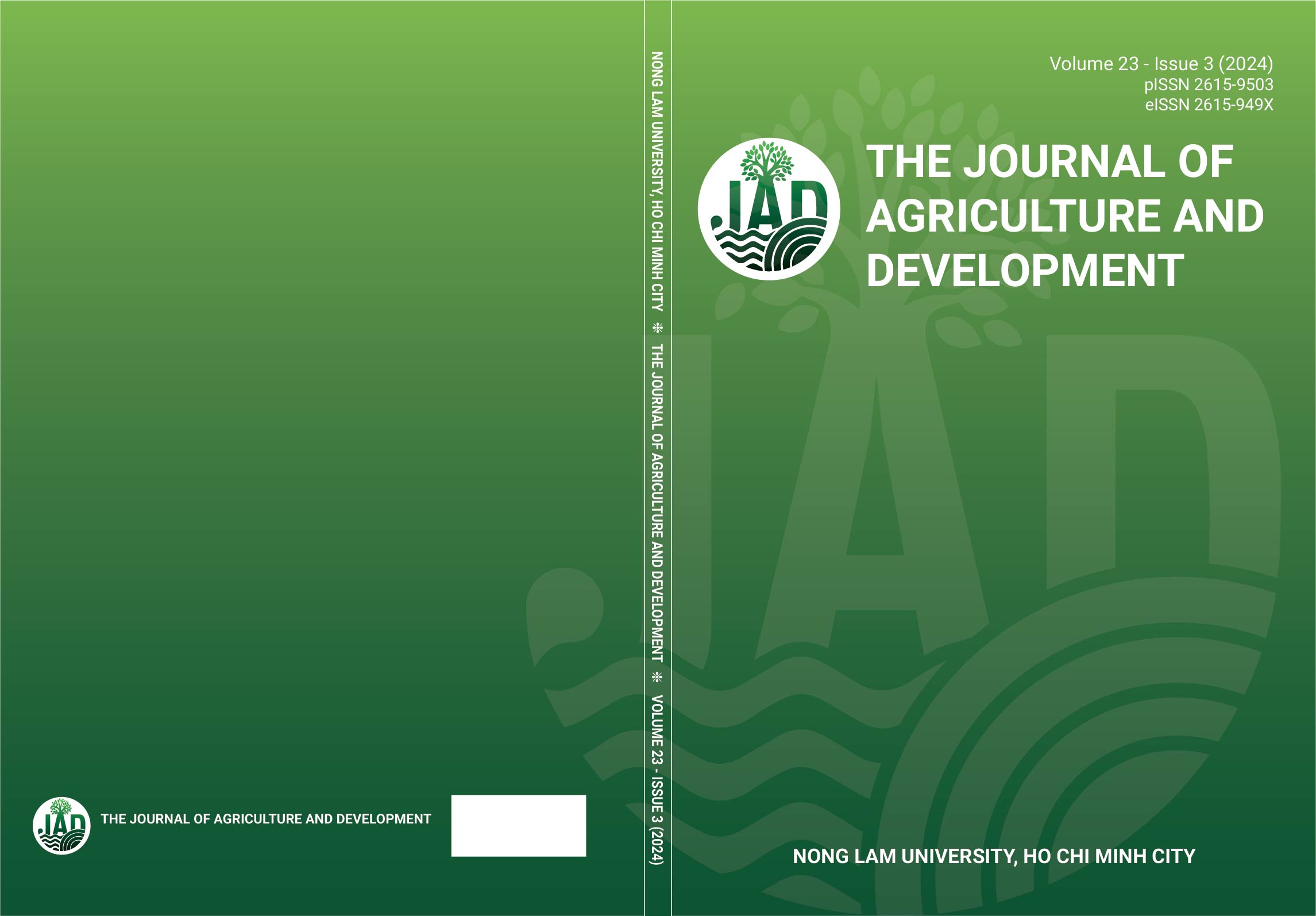Investigation of small-scale farming status of Tire track eel (Mastacembelus favus) in the Mekong Delta, Vietnam
Main Article Content
Abstract
Tire track eel (Mastacembelus favus) is an economically important freshwater fish in the Mekong Delta. However, there is a lack of academic information about the current farming status, feed, and feeding related to this species in the region. Therefore, a field survey of small scale farming of tire track eel was conducted in An Giang, Dong Thap, Hau Giang and Kien Giang provinces of Vietnam. The objective of the survey was to determine the current farming practices information on households, especially the feed and feeding status of tire track eel in order to improve and develop a suitable feed for this fish in the future. The results showed that most of the small-scale farmers cultured fish in earthen ponds with or without plastic liners. Tire track eels were fed with feeds of other species and typically fed 3 - 5 times/d during the fingerling stage, and twice per day during the grow-out period. In terms of feed ingredients, crude protein contents in the feeds were 39.5 - 45.5% while crude lipid contents were 7.7 - 12.7%. Feed conversion ratios of tire track eels were 2 - 5. The farming periods of fish were 11.8 - 14 months when the fish reached the harvesting sizes of 318.2 - 421.4 g/fish, with the survival rates of 40 - 80%. It took 2.5 months to cultivate the fingerling stage (around 3 g/fish) from the fry with the survival rate of 55.7%. It was reported that this species was raised with a simple technique and got less illness compared to other fish species. However, the main reason of fish deaths during farming period related to management factors such as poor water quality due to decomposition of uneaten feed in water or lacks of dissolved oxygen due to high stocking density or power supply failures.
Article Details
References
Ahmad, A. B., Zaini, N., Nayan, N., Fahmi-Ahmad, M., Rizal, S. A., & Yusuf, Y. (2018). Freshwater fish diversity of Sungai Setiu, Terengganu, Peninsular Malaysia. Malayan Nature Journal 70(4), 499-507.
AOAC (The Association of Official Analytical Chemists). (2000). Official methods of analysis of AOAC international (17th ed). Maryland, USA: The Association of Official Analytical Chemists.
Jamaluddin, J. A. F., So, N., Tam, B. M., Ahmad, A., Grudpan, C., Md Sah, A. S. R., & Mohd Nor, S. A. (2021). Genetic diversity of the tire track eel Mastacembelus favus in Southeast Asia inferred from microsatellite markers. Ichthyological Research 68, 529-540. https://doi.org/10.1007/s10228-021-00807-4.
Jamaluddin, J. A. F., So, N., Tam, B. M., Ahmad, A., Grudpan, C., Page, L. M., Khaironizam, Md. Z., & Mohd Nor, S. A. (2019). Genetic variation, demographic history and phylogeography of tire track eel, Mastacembelus favus (Synbranchiformes: Mastacembelidae) in Southeast Asia. Hydrobiologia 838(1), 163-182. https://doi.org/10.1007/s10750-019-03987-3.
Knight, A. (2022). What is a smallholder farmer? Heifer International. Food and Waste, Retrieved December 15, 2022, from https://www.heifer.org/blog/what-is-a-smallholder-farmer.html.
Loan, P. P. (2010). Developing an artificial seed production process for Tire track eels (Mastacembelus favus) fish in An Giang (research report). An Giang Department of Science and Technology, An Giang, Vietnam.
Mongabay. (2020). Mastacembelidae (Spiny eel) family. Tropical fish. Retrieved from April 12, 2020, from https://fish.mongabay.com/mastacembelidae.htm.
NRC (National Research Council). (1993). Nutrient requirements of fish. Washington, USA: National Academy Press.
Pethiyagoda, R. (1991). Freshwater fishes of Sri Lanka. Colombo, Sri Lanka: Wildlife Heritage Trust of Sri Lanka.
Phan, L. T., Bui, T. M., Nguyen, T. T., Gooley, G. J., Ingram, B. A., Nguyen, H. V., & De Silva, S. S. (2009). Current status of farming practices of striped catfish, Pangasianodon hypophthalmus in the Mekong Delta, Vietnam. Aquaculture 296(3-4), 227-236.
Rainboth, W. J. (1996). Fishes of the cambodian mekong. Wisconsin, USA: Food & Agriculture Organization of the United Nations.
Riede, K. (2004). Global register of migratory species: from global to regional scales: final report of the R&D-Projekt 808 05 081. Bonn, Germany: Federal Agency for Nature Conservation.
Sokheng, C., Chhea, C. K., Viravong, S., Bouakhamvongsa, K., Suntornratana, U., Yoorong, Nguyen, T. T., Tran, B. Q., Poulsen, A. F., & Jorgensen, J. V. (1999). Fish migrations and spawning habits in the Mekong mainstream: a survey using local knowledge (basinwide). Assessment of Mekong fisheries: Fish migrations and spawning and the impact of water management project (AMFC). AMFP Report 2, 99.
Tran, T. (2016). U Minh peat swamp forest: Mekong river basin (Vietnam). New York, USA: Springer. https://doi.org/10.1007/978-94-007-6173-5_174-4.
Trieu, N. V. (2010). Study on biological characteristics of Mastacembelus armatus. Can Tho University Journal of Science 2010(15b), 70-80.
Trung, N. T. (2010). Artificial propagation of tire track eel (Mastacembelus favus) (research report). Can Tho Department of Science and Technology, Can Tho, Vietnam.
Vázquez-Ortiz, F., Caire, G., Higuera-Ciapara, I., & Hernández, G. (1995). High performance liquid chromatographic determination of free amino acids in shrimp. Journal of Liquid Chromatography and Related Technologies 18(10), 2059-2068.








